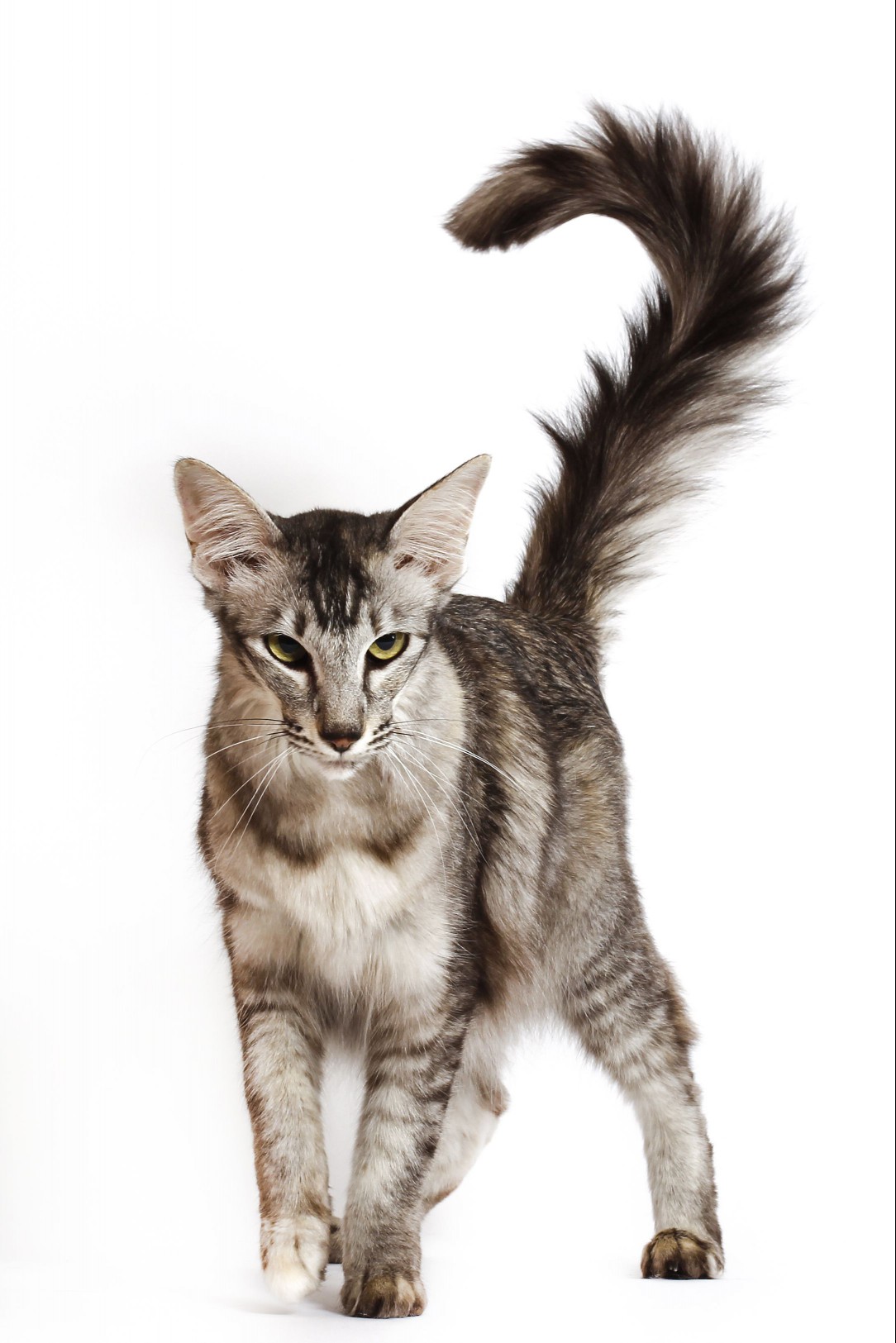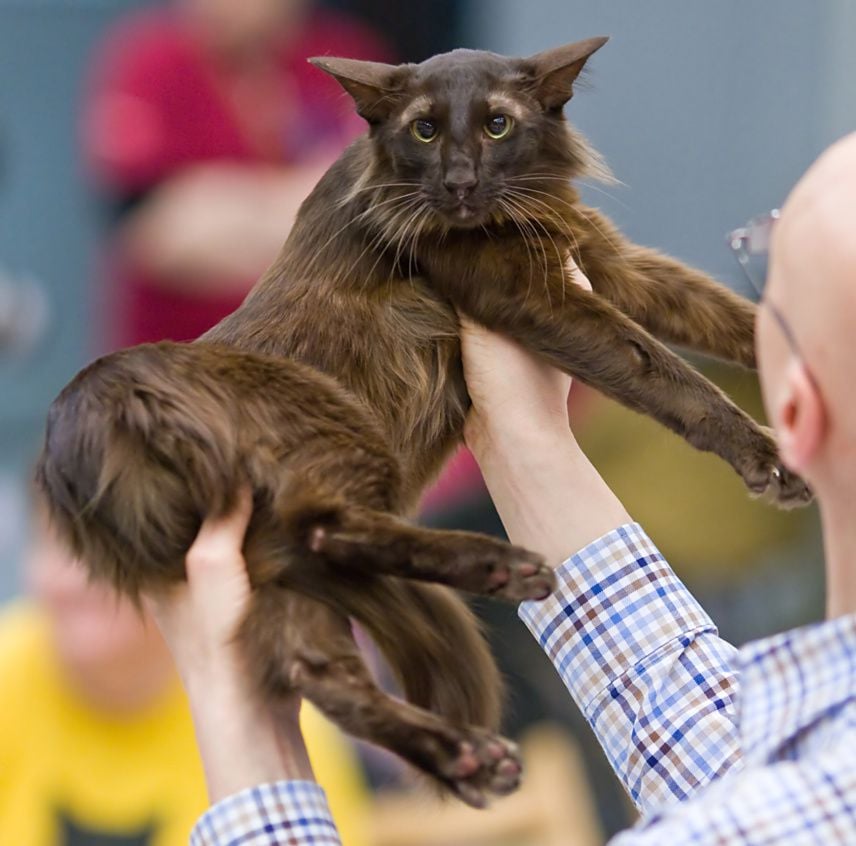Oriental Longhair: Cat Breed Profile, Characteristics & Care
The elegantly built oriental longhair, also known as the British angora, resembles its relative the Siamese but has a much more recent history, officially recognized by the Cat Fanciers' Association in 1995. Its long, silky coat comes in an outstanding array of color and pattern combinations, and the cat is as personable as it is pretty. This curious, easygoing, and talkative breed is best suited to a home with lots of people or an extremely dedicated single owner. The oriental longhair loves company and hates to be left alone for long.
Breed Overview
Other Names: British angora, Javanese, Mandarin
Personality: Friendly, curious, sociable, talkative
Weight: Up to 12 pounds
Length: Up to 18 inches
Coat Length: Long hair
Coat Colors: Black, white, blue, chocolate, lilac, cinnamon, caramel, fawn, red, cream, apricot
Coat Patterns: Tabby, solid, bicolor, tortoiseshell, colorpoint
Eye Color: Green, blue, or odd-eyed
Lifespan: Up to 15 years
Hypoallergenic: No
Origin: United Kingdom
Oriental Longhair Characteristics
Like its well-known ancestor the Siamese, the oriental longhair is full of personality—and isn't shy about showing it. These cats are vocal and enjoy communicating with people. While they are very outgoing, they have a good-natured temperament that prevents them from being aggressive or even too annoying (most of the time).
They are energetic and curious, so they love playing games, especially with their housemates. People are often preferred, but oriental longhairs also appreciate the companionship of other cats and gentle dogs.
| Affection Level | High |
| Friendliness | Medium |
| Kid-Friendly | High |
| Pet-Friendly | High |
| Exercise Needs | Medium |
| Playfulness | High |
| Energy Level | High |
| Intelligence | High |
| Tendency to Vocalize | High |
| Amount of Shedding | Medium |


History of the Oriental Longhair
Oriental cats can be categorized as long or short-haired, with the short-haired variety being much more common. While it is rumored that an early version of the oriental longhair was developed in Turkey in the 19th century, the introduction of the popular Persian cat rendered the lesser-known long-haired cat obsolete.
In the mid-20th century, breeders wanted to develop Siamese-like cats with a greater variety of coat colors and patterns. They began crossing Siamese with other breeds like Russian blues, British shorthairs, and Abyssinians. This was how the oriental cat was first born, and by the 1970s, they were being imported to the United States where they became incredibly popular.
The oriental shorthair cat was recognized as a breed by the Cat Fanciers' Association (CFA) in 1977, not yet accepting the longhair as a distinct breed. The International Cat Association (ICA) recognized the oriental longhair as a breed in its own right in 1979, but it wasn't until 1995 that the CFA officially added the longhair to its listing.
While the short and long-haired varieties are similar in temperament, the longhair has a more lustrous, silky coat, and has an impressive plumed tail. This breed is sometimes also referred to as the British angora, which it was called until the early 21st century.
Oriental Longhair Care
Exercise
The oriental longhair has a lot of energy, so it loves to explore, play games, and tackle toys. One fun way to interact with this curious kitty (and keep its brain busy) is training. As far as cats go, this breed is surprisingly trainable. The longhair is incredibly smart and inquisitive and responds well to positive reinforcement training methods. This will strengthen the bond you have with your cat while keeping it stimulated and entertained.
Grooming
The oriental longhair does not have a double coat so, even though the hair is long, it doesn't require the intensive grooming of longer-haired breeds like the Persian. A good brush-out once a week to remove dead hairs should suffice.
Common Health Problems
The oriental longhair is generally considered a healthy breed, but there are a few genetic conditions that can affect this breed, including:
- Kinked Tails and Crossed Eyes: These are inherited quirks from their Siamese relatives. Neither trait is harmful, but crossed eyes may affect the acuity of your cat's vision, making it vulnerable to injury—especially if it goes outside.
- Progressive Retinal Atrophy: This is a gradual degenerative condition that ultimately leads to blindness.
- Liver Amyloidosis: This condition involves amyloid proteins being deposited in the liver, and this reduces function and can lead to liver failure.
Appearance
The oriental longhair looks similar to a Siamese, with its triangular heads, large ears, and almond-shaped eyes. But, the longhair has an even lankier and more slender body with a long, plumed tail.
The breed is also known for its vast array of coat colors and patterns. At close to 300 variations, the oriental longhair offers significantly more variety than any other breed except its short-haired counterpart.
Diet and Nutrition
The breed is prone to periodontal disease, presumably because its long, slim face and jaw contribute to accumulated bacteria and plaque. It is important to feed high-quality food, preferably dry food in addition to canned, to help remove build-up. Tooth brushing—if your cat tolerates it—as well as veterinary dental cleanings can also be beneficial.
Where to Adopt or Buy an Oriental Longhair
Seeking out a reputable breeder will help to ensure that your kitten is healthy and well socialized when you bring it home. Make sure that you do a ton of research before deciding if an oriental longhair is the right cat for you (remember, this is a very vocal breed). Talk to other owners, breeders, and breed clubs to get more information.
A good place to start your research is through the Cat Fanciers' Association's list of recognized breeders.
Adopting a cat can be hugely rewarding, so you can try reaching out to your local shelter or searching Petfinder for an oriental longhair. While these pure-bred cats are not extremely common, you never know when one might be abandoned and need a home.
Oriental Longhair Overview
Oriental longhairs share many traits with their Siamese relatives. They are exceptionally curious and clever and, unless you keep them appropriately stimulated, they can get into mischief to entertain themselves. For this reason, they are best suited to households where they will have plenty of company.
Their affectionate and amiable personality means they also thrive among families with respectful kids as well as multi-pet households. If introductions are done properly, it is not uncommon for an oriental longhair and a dog to become fast friends.
Affectionate and sociable
Enjoys the company of children and other animals
Playful and intelligent
Very vocal
Needs a lot of company and stimulation
Prone to periodontal disease

More Cat Breeds and Further Research
If you’re interested in similar breeds, check out:
- Siamese
- Lynx Point Siamese
- Tonkinese
Otherwise, check out all of our other cat breed profiles.
- How much does a oriental longhair cat cost?
An oriental longhair cat can cost between $400 and $2,000, depending on whether it is considered pet quality or breeding quality.
Where is the oriental longhair from?The breed originated in the UK and was further developed in the US.
Do oriental longhairs talk a lot?These cats are very vocal, expressing most of their wants, needs, and "opinions" with loud, deep meows.